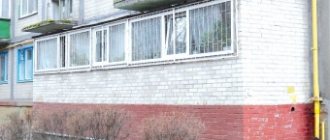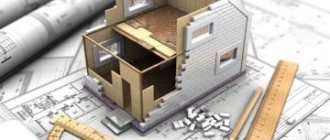The extension is a new part of the property. It is erected during the design and approval of reconstruction, as the original parameters of the building change. When designing, it is necessary to determine the possibility of increasing the area of the facility, comply with permissible loads, choose the right decisions about layout, connecting the engineering systems of the new part to existing networks.
Get an estimate of the cost of this service using our price calculator - here
In this material, read what a reconstruction project for an extension should contain, what regulations the designer will use, and how to choose the right design organization.
What is an extension and how to approve it in 2021
An extension occurs by expanding the area and external contours (walls) of the building, connected by at least one passage, load-bearing and enclosing structures. Since the area and volume of an object are among its main parameters, the addition of new parts refers to reconstruction. Such types of work can only be carried out on the basis of a project or construction permit. After completion of the reconstruction, the owner must undergo cadastral registration and reflect changes in characteristics in the Unified State Register of Real Estate.
Regulations
The basic rules for pre-project preparation, design and approval of reconstructions for extensions are regulated by the Civil Code of the Russian Federation (Urban Planning Code). A mandatory requirement of this act is the examination of project documentation, obtaining a construction permit and commissioning. The composition and content of the project are determined by Decree of the Government of the Russian Federation No. 87.
Dear Clients!
The information in this article contains general information, but each case is unique. You can get a free consultation from our engineers using one of our telephone numbers - call:
8 Moscow (our address)
8 St. Petersburg (our address)
All consultations are free.
Depending on the functional purpose and type of building, the designer will apply the following building codes:
- SP 56.13330.2011 for industrial buildings ();
- SP 118.13330.2012 for public buildings ();
- SP 54.13330.2016 for apartment buildings ();
- NPB 110-03 Fire safety standards ();
- SNiP 21-01-97 Fire safety ().
Also, the construction and reconstruction of all public safety buildings are subject to the provisions of Law No. 384-FZ (Technical Regulations on the Safety of Buildings). Special SP and SNiP will be used for the design of utilities and other mandatory systems of the facility.
The extension and the main building must have a connecting passage
In simple terms
The extension is not an independent piece of real estate, as it will not have signs of isolation and isolation. After completion of construction work, it will be attached to the main facility and become its integral part. Consequently, after reconstruction, engineering communications (heating, drainage and water supply, electricity, etc.) will be expanded to the new area and volume of the building. Although to connect an extension a passage must be made into a previously existing part of the building, it may have separate access to the street, windows, i.e. all the normal elements of an object.
Documents for registering a capital structure
To register a major extension you will need the following documents:
- A package of documents for residential real estate - about ownership, technical, an extract from the house register about the composition of persons living (registered) at this address;
- Documents for the land plot to confirm ownership;
- Consent of each registered person for construction (in writing);
- Permitting documentation from housing and communal services and SES;
- Real estate project with amendments;
- Written consent of neighbors;
- Photos of land, buildings.
At the first stage, you should contact the administration, namely the architectural department, to submit an application for construction. After this, a commission goes to the site’s address and makes a decision. If the owner has permission, the commission checks how well the property complies with the new plan. If the decision is positive, the owner receives a deed and, on its basis, registers ownership.
Important! If you want to avoid problems and simplify the procedure for legalizing an extension as much as possible, you need to use the services of a specialized company to prepare the project. It is important that she has the appropriate license.
Upon completion of construction, the State Commission is invited, which draws up an act, which records the compliance of the object with the project. With the act, the owner has the right to contact the BTI to register the completed project. After which the changes are made to Rosreestr.
Inspection before designing an extension before reconstruction
Since the original structures of the facility will be impacted during the construction of the extension, they need to be examined with the assistance of experts. Based on the results of the survey, a conclusion will be drawn about the possibility of carrying out work, additional measures to strengthen the bearing capacity of the foundation, floors, and other elements. The survey also allows you to obtain objective data on the condition of all systems and communications of the facility, which can be replaced or upgraded during a single repair.
Who carries out building inspections in 2021
As with other reconstruction options, the following will be involved in the inspection of the site:
- representatives of the design and contracting organization;
- experts in real estate, construction and architecture;
- engineers, architects, technicians, power engineers, land managers, and other specialized specialists.
The survey will be comprehensive, since extension work can have an impact on all parts of the building and system.
Inspection of the technical condition of the building is mandatory before design
What is examined in a building to design an extension?
The main purpose of the surveys is to determine the possibility of an extension, taking into account the actual state of the structures, and to prepare recommendations for ensuring safety. The commission will examine:
- all load-bearing and non-load-bearing structures of the object - foundation, floors, walls, flights of stairs, partitions, other elements of architecture and planning;
- external facades of the building, since their characteristics will necessarily change during the extension;
- all engineering networks and communications, since during the extension they will expand to new areas and be laid according to new schemes;
- the condition of the land plot, since a permanent foundation needs to be laid for the extension;
- other elements of the building and site.
Surveys and surveys will take into account the limitations of the GPZU. For example. this document may contain restrictions on the area or height of buildings on a given site. Taking into account such restrictions, a different location for the extension and its architectural features can be chosen.
Specialists conduct an external inspection of the building at the site where the extension is being built
Basic methods and tools for inspection before building an extension
Since the expert commission will decide on the possibility of reconstruction according to the presented option, a full range of methods is used for the examination:
Dear Clients!
The information in this article contains general information, but each case is unique. You can get a free consultation from our engineers using one of our telephone numbers - call:
8 Moscow (our address)
8 St. Petersburg (our address)
All consultations are free.
- study of the original technical and operational documentation for the building, passports of individual systems;
- visual inspection of structures and facades;
- surveys on the site and underground communications;
- opening individual structures and floors to determine physical and moral wear and tear;
- instrumental diagnostics, photo and video shooting;
- calculations, measurements with preparation of documents;
- laboratory tests, tests, research.
Stages of designing an extension during reconstruction
The basis for developing a reconstruction project is the owner’s technical specifications, the results of engineering surveys and surveys. When preparing a project, fill in the following information:
- initial data for the object, corresponding to the technical documentation and survey results;
- architectural, planning, constructive, engineering and other solutions, their justification;
- text description of all selected solutions, reinforcements of existing structures;
- information on technical conditions for connecting energy resources, consumption limits and points of connection to building networks or general-purpose communications;
- situational plan of the site reflecting the location of the extension and the original object;
- a block with fire safety measures for the extension and for the period of work;
- construction organization project, i.e. sequence of processes and stages of work for the contractor;
- other data, depending on the characteristics of the building, characteristics and parameters of the extension.
The project is accompanied by working documentation, diagrams and drawings, and other graphic materials. After approval of the documents of customers and designers, they are sent for examination. If you have a positive expert opinion, you can contact the construction supervision authorities to obtain a construction permit.
Expert commentary. During the extension work, the contractor must strictly follow the project, organizational plans, fire and other safety requirements. These points will be monitored by construction supervision authorities during reconstruction and checked when issuing permission to put into operation. At the final stage of approvals, you need to obtain a technical plan for the new characteristics of the building and undergo cadastral registration with Rosreestr. You can order a technical plan from the cadastral engineers ]Smart Way[/anchor].
The main building and the extension can have a common foundation
Legalization of unauthorized buildings
The preparatory procedure and official legalization of an extension to a house before its construction does not take much time.
However, according to statistics, 80% of a hundred homeowners begin collecting documents and registering capital structures after their construction.
The worst thing is if the registration of unauthorized construction begins years later, when it becomes necessary to carry out transactions with real estate, selling it or re-registering it to another owner.
In these cases, legalization will have to begin with the courts. The plaintiff is the owner of the suburban area, and the municipal authorities are the defendant.
The homeowner, as a plaintiff, may go to court not only in cases where it is necessary to legalize an unauthorized extension, but also when the competent authorities refuse to issue a permit for new construction.
In both cases, a package of supporting documents must be attached to the statement of claim written according to the established template. These include previously obtained permits and approvals for the construction site and design documentation.
If the court decision is positive (and, more often than not, it happens), the homeowner receives the appropriate legal document and a receipt for payment of penalties for documentation not completed on time.
When preparing a package of documents for the court, you need to pay attention to the following:
- All documentation must be completed in accordance with current building codes.
- Originals of all documents confirming ownership rights are required.
- All applications and permissions must be handwritten by the signatory or certified by a notary (consent of co-owners, neighbors).
- It is mandatory to certify that the materials used in the construction of the extension are environmentally friendly and comply with sanitary standards.
The court's refusal is valid in cases of an incorrectly or negligently executed package of documents or when an unauthorized structure was constructed in violation of construction or sanitary and epidemiological standards. Also, a refusal to register can be issued by a court if the structure endangers the lives of people or was erected in violation of the legal and legal rights of co-owners of the property and neighbors.
Qualifications of designers - who should design the extension and who is best to look for
The design and other documents for an extension during reconstruction can only be drawn up by a design organization that is a member of the SRO. This point must be checked at the stage of concluding the contract, since otherwise a negative expert opinion will be received. It is also advisable to verify the qualifications and experience of the designer, especially in similar types of work. For example, ]Smart Way[/anchor] always offers examples of previously completed orders, so the client can immediately make an objective and informed decision. Contact us, we will explain in detail the legal requirements for the design and approval of an extension, and offer favorable terms of cooperation.
Cost and time frame for designing an extension
It is impossible to estimate the timing and cost of design work without studying the initial documentation for the facility and technical specifications. It is also necessary to conduct a preliminary survey of the object and site, since their features can complicate or simplify the designer’s work. ]Smart Way[/anchor] always offers affordable prices for design, will provide short deadlines for completing documents with a guarantee of quality. Preliminary prices and terms can be clarified by calling the numbers listed on the website.
Get an estimate of the cost of this service using our price calculator - here
How to draw up technical specifications for designing an extension in 5 minutes
When drawing up technical specifications, you need to accurately indicate the initial data on the object being reconstructed, its characteristics and functional purpose, requirements for the upcoming work and the content of the project. It is difficult to do this on your own, since you will have to take into account many requirements and restrictions of the law and construction codes. We offer services for the preparation of technical specifications for any type of work, including the design and construction of extensions. On our website you can find an example of technical specifications in this area. You can learn more about the conditions for drawing up technical specifications at a free consultation with our specialists.
Registration of non-permanent construction
How to legalize a non-permanent extension? It's actually very easy to do this. First of all, you need to find a local technical inventory bureau (BTI). After this, a complete package of documentation for the house is collected, which should be taken to the above-mentioned authority. The bureau draws up a special application for amendments to technical house documents. This can be done both before the construction of the extension begins and after. The question of which of these two options is more convenient is obvious. The best option would be to design an already constructed non-capital facility, because all the data is already known exactly, and major changes are unlikely to follow. But there is one small problem here. Although this is unlikely, the BTI may refuse permission for an extension. Of course, there must be serious reasons for this. That is why it is better to play it safe and coordinate the construction of a non-capital type facility in advance.
A special acceptance committee must come from the bureau to draw up a certificate of completion of the reconstruction. When the BTI returns the full package of documents, the issue can be considered resolved.
If there are several owners in the house, then a written agreement for an additional non-capital type object from each of the residents will be required.
Difficulties and limitations when designing an extension
As with other reconstruction options, designing an extension can be accompanied by difficulties, problems and limitations:
- the GPZU may contain restrictions on maximum permissible construction parameters, the presence of sanitary, water protection and other special zones;
- the designer must take into account the limitations of the urban planning documentation of the settlement regarding facade and architectural solutions, and the height of the attached parts of the building;
- difficulties may arise due to technical conditions for connection, since the allocated energy resource limits may be insufficient for the loads and capacities of the new part of the facility;
- a technical and expert opinion may contain a conclusion that it is impossible to build an extension according to the proposed option, so its location or characteristics will have to be changed.
If it is necessary to strengthen the load-bearing structures of the building, the designer will have to develop additional solutions, change the architecture or layout of the extension. You won’t have to worry about any problems that arise if the design is handled by the specialists of ]Smart Way[/anchor]. We have worked on many objects, including those of increased complexity, and we will take into account all the requirements and restrictions at the initial stage of work on the project.
Extension to a residential building
Whether an extension has the status of capital or non-capital depends on the technical features of its design. The following non-permanent extensions are distinguished: entrance groups (stairs, porches) on the first floors of buildings with a total area of no more than 10 square meters. m. without foundation construction; terraces made of prefabricated structures with a total area of no more than 30 square meters. m without building height, heating organization and equipment with engineering and sanitary equipment; canopies without adding walls, which does not involve increasing the height of the building, heating or equipping with engineering and sanitary equipment; showcases (with a distance of no more than 1 m relative to the external walls of the building), etc.
Interesting: When will the men who participated in the liquidation of the accident at the Chernobol nuclear power plant in Kazakhstan retire?
In this case, it is also necessary to follow the rule when a new room is not built through a supporting structure. This is done in order to protect not only the residents of the apartment, but also others in the apartment building; load-bearing structures “hold” the height, which allows the house to remain safe. But at the same time, it is necessary to somehow provide an exit from the extension: either redo the window opening, or create a new entrance.
conclusions
The construction of an extension refers to reconstruction, since the basic parameters of the building change. The specified work can only be performed on a project that has received a positive expert opinion. Construction permit. You can draw up design documentation for reconstruction in an organization that is a member of the SRO.
Get an estimate of the cost of this service using our price calculator - here
A full range of services for designing construction and reconstruction is provided by ]Smart Way[/anchor]. You can clarify the terms of cooperation, get a free consultation and order a project by calling the numbers listed on the website.








